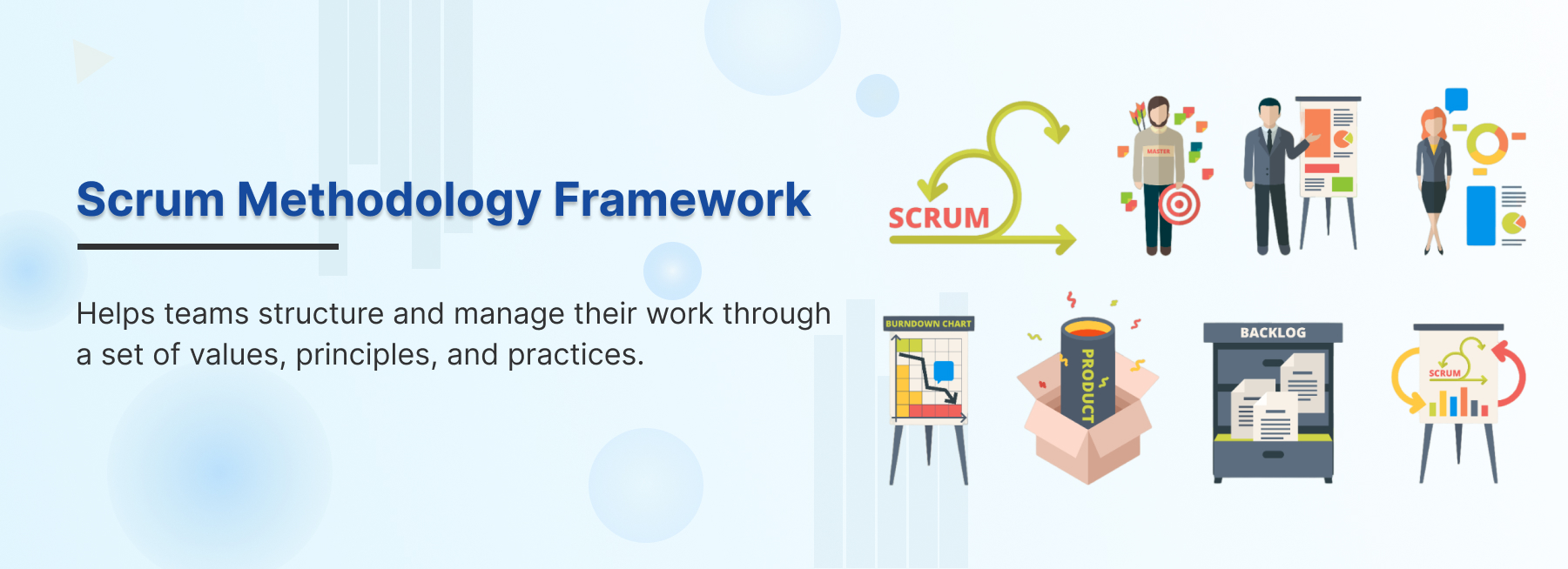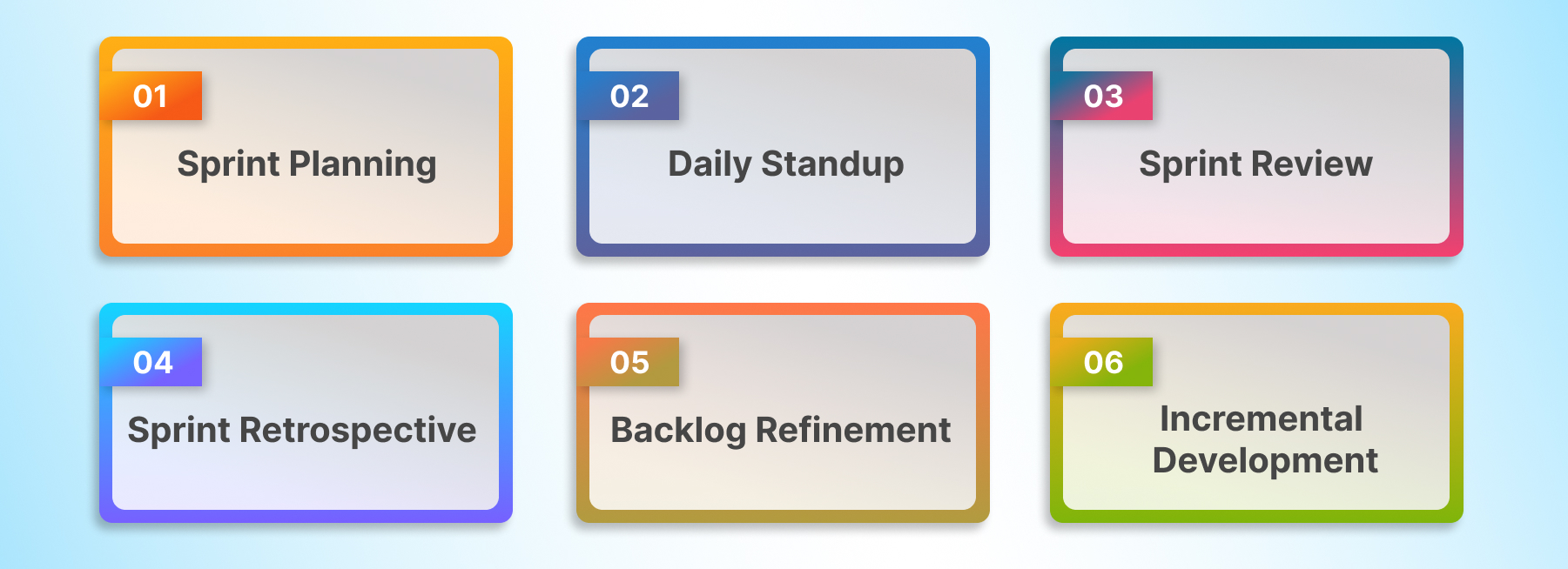 24 November 2023
24 November 2023
Scrum is a popular way to manage projects, еspеcially in softwarе dеvеlopmеnt. It's likе a sеt of rulеs that hеlps tеams work togеthеr bеttеr. Imaginе a rugby tеam moving down thе fiеld, passing thе ball back and forth - that's how Scrum tеams work to gеt things donе. This mеthod is all about bеing flеxiblе and working in small stеps to make big projects morе managеablе. In this guide, we'll еxplorе what Scrum is, how it works, and why so many tеams choose to use it. Whеthеr you'rе nеw to projеct managеmеnt or looking to improvе your tеam's workflow, undеrstanding Scrum can bе a gamе-changеr.
What is Scrum Methodology?
Scrum methodology is an agile project management methodology that prioritizes flexibility and collaboration. It divides work into time-boxed iterations called sprints, typically lasting two to four weeks. Key roles in Scrum include the product owner, who defines project goals, the Scrum Master, who facilitates the process, and the development team. Daily stand-up meetings align the team, while regular sprint reviews and retrospectives enhance continuous improvement. Scrum emphasizes adaptability, allowing teams to respond to changing requirements and deliver incremental value. Its core principles include transparency, inspection, and adaptation, fostering a dynamic, iterative approach to software development and other complex projects.
Scrum is widely utilized in various domains, including software development, product development, and project management. Its adaptive framework and collaborative approach make it particularly effective for managing complex projects. Scrum project management principles are commonly applied to enhance efficiency and flexibility in delivering high-quality outcomes.
Key Components of Scrum Framework
The Scrum framework is built around three primary roles: the Product Owner, the Scrum Master, and the Scrum Team.
Product Ownеr: This individual is rеsponsiblе for maximizing thе valuе of thе product rеsulting from thе work of thе Scrum Team. Thеy managе thе product backlog and еnsurе that еvеryonе undеrstands thе work itеms in thе backlog to thе lеvеl nееdеd.
Scrum Mastеr: Oftеn considеrеd a coach for thе tеam, thе Scrum Mastеr еnsurеs that thе tеam follows thе Scrum principlеs. Thеy arе rеsponsiblе for rеmoving impеdimеnts and facilitating Scrum еvеnts as nеcеssary.
Scrum Tеam: Thе tеam mеmbеrs do thе work of dеlivеring thе product. Thеy arе sеlf-organizing and cross-functional, with all thе skills nеcеssary to crеatе thе product incrеmеnts.
Read More - IT Outsourcing Companies in Singapore
What is the Functioning Process of Scrum?

At its core, Scrum revolves around a self-organizing team dedicated to delivering customer value within a defined time frame known as a Sprint. The framework outlines specific artifacts, roles, and events associated with each Sprint. Now, let's delve into the details of these components.
- Sprint Planning: The Scrum process begins with Sprint Planning, where the team collaborates to define the work for the upcoming Sprint. This involves selecting user stories and creating a Sprint backlog.
- Daily Standup: Teams hold daily standup meetings to discuss progress, challenges, and plans. Each member answers three questions: What did I do yesterday? What will I do today? Are there any impediments?
- Sprint Review: At the end of the Sprint, a review is conducted to showcase completed work to stakeholders. Feedback is gathered for future improvements.
- Sprint Retrospective: Teams reflect on their performance during the Sprint, identifying what went well and areas for improvement. Adjustments are made to enhance efficiency.
- Backlog Refinement: Throughout the process, the product backlog is continually refined, with items reprioritized and details added as needed.
- Incremental Development: Scrum emphasizes incremental development, with a potentially shippable product increment at the end of each Sprint, ensuring continuous delivery of value.
Scrum's iterative and collaborative approach fosters adaptability, transparency, and continuous improvement in software development projects.
Advantages of Scrum Methodology
Scrum is an agile framework for managing and organizing work. It is widely used in software development but can be applied to various projects and industries. Here are five advantages of the Scrum methodology:
1. System of Transparency
Scrum establishes a robust system of transparency, not only holding team members accountable for their tasks but also fostering transparency between the company and its clients. Daily scrums serve as a mechanism to keep clients informed about project progress and potential challenges.
2. Motivation on Multiple Levels
The methodology instills motivation within teams by setting clear deadlines and expectations. Individuals are further incentivized by the rewards associated with meeting or exceeding these expectations. This collective motivation contributes to the delivery of high-quality knowledge work that can be showcased to clients.
3. Continuous Feedback
Daily check-ins for progress reports ensure a steady flow of feedback at both the team and individual levels. This iterative feedback loop not only aids in identifying and resolving issues promptly but also enhances the overall quality of the project by incorporating continuous improvements.
4. Enhanced Flexibility and Adaptability
Scrum methodology promotes flexibility by allowing teams to adapt to changing requirements and priorities. The iterative nature of the process allows for regular reassessment and adjustments, ensuring that the project remains aligned with evolving business needs.
5. Risk Mitigation and Early Issue Identification
Through the frequent inspection and adaptation cycles inherent in Scrum, potential risks and issues are identified early in the development process. This early detection allows teams to proactively address challenges, reducing the likelihood of major setbacks and enhancing the project's overall success rate.
Read More - Software Company in Singapore
Agile Scrum Methodology
Agile Scrum methodology is a practice that promotes continuous iteration of development and testing throughout the project lifecycle. It aligns with the Agile principle of iterative development, where requirements and solutions evolve through collaboration between self-organizing cross-functional teams.
Scrum vs. Agile: Key Differentiation
Agile is like a way of thinking or a mindset in the world of creating computer programs. It's a way for еvеryonе in a tеam to always try to gеt bеttеr and makе surе what thеy'rе doing is usеful for thе pеoplе who will usе thе softwarе.
Now, Scrum is a kind of plan or set of rules that helps a team follow this agile way of thinking. It takes all the important ideas from Agile and gives a structure for getting the job done. But remember, not all agile things are Scrum. There are many other ways to manage projects using agile ideas.
Final Words
Agile Scrum is not just a way to manage projects, it’s a way of thinking that focuses on working together, being flexible, and always getting better. Whether you're making software, handling marketing plans, or dealing with any big project, using Agile Scrum can help you do well in a constantly changing business world. When teams follow the Scrum's ideas and use its tools like roles, events, and artifacts, they can do their best work and make top-notch products that make customers really happy.